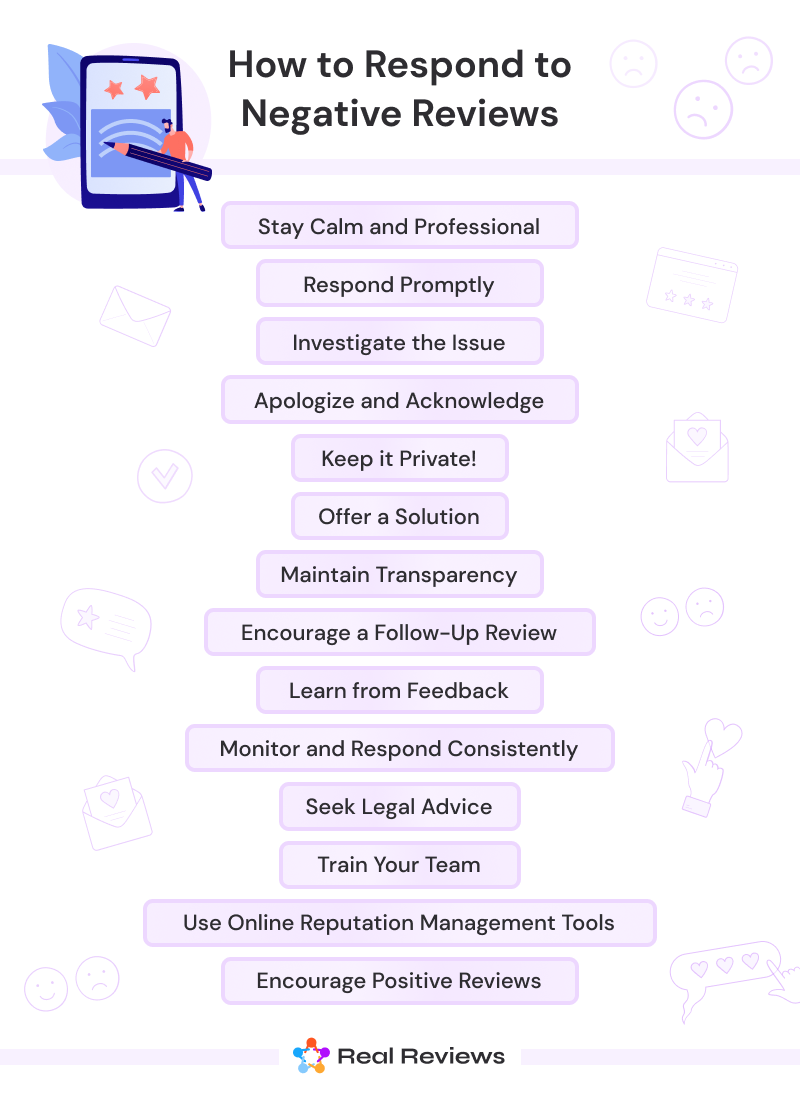
What Are Examples and Tips for Handling Negative Reviews?
Negative reviews can be a thorn in the side of any business owner, but they are an inevitable aspect of maintaining an online presence and protecting brand reputation. Often, these unfavorable evaluations stem from customer service mishaps, product issues, or even simple misunderstandings.
Knowing how to respond to negative reviews professionally is crucial for turning a bad situation into an opportunity for improvement. Similarly, having a strategy to reply to negative reviews can mend fences with unhappy customers and portray your business as one that values customer feedback, understands how to handle criticism, and is committed to resolving issues.
Online reviews on sites like Yelp, RealReviews, SiteJabber, Google My Business, and TripAdvisor significantly shape public opinion about your brand. A bad review can significantly impact potential customers' perceptions and your bottom line. Hence, it's essential to respond to negative reviews and do so in a way that shows your commitment to customer satisfaction.
In the upcoming sections, we'll explore actionable tips and real-world examples to help you navigate the complex terrain of negative (and positive) online reviews. Equipped with this knowledge, you can fortify your online reputation, enhance building brand loyalty, and continue to build a brand that customers trust and recommend.

Table of Contents
- How to Respond to Negative Reviews
- Stay Calm and Professional
- Respond Promptly
- Investigate the Issue
- Apologize and Acknowledge
- Keep it Private!
- Offer a Solution
- Maintain Transparency
- Encourage a Follow-Up Review
- Learn from Feedback
- Monitor and Respond Consistently
- Seek Legal Advice
- Train Your Team
- Use Online Reputation Management Tools
- Encourage Positive Reviews
- Free negative review response examples
- Review responses for fashion brands
- Review response for retail
- Review response for car dealerships
- Review responses for financial companies
- Review responses for SaaS companies
- Review response for home service
- Review response for education
- Why Should You Respond to Negative Online Reviews?
- FAQs
Brand Reputation Management & Responding to Negative Feedback
Responding to customer feedback is an integral part of running a successful business. While positive reviews help bolster your image, negative reviews offer valuable opportunities for growth and improvement. Addressing negative feedback is particularly crucial. Timely and thoughtful responses to negative reviews can prevent damage to your company's reputation and even convert unhappy customers into loyal ones.
Your reaction demonstrates that you are committed to customer satisfaction and willing to make amends. As we delve into the strategies outlined in the following sections, you'll gain a comprehensive understanding of the best ways to handle negative customer feedback, thereby enhancing consumer perception and fortifying your brand's standing.
Stay Calm & Professional - Customer Service Strategies for Bad Reviews
It's easy to let emotions cloud your judgment in the heat of the moment, but that's precisely when emotional intelligence becomes invaluable. When faced with a negative review, your initial response might be defensive or emotional, but it's crucial to step back and approach the situation with professionalism and maturity.
Take time to fully understand the complaint and view it as an opportunity to improve rather than an attack. Your demeanor sets the tone for future customer relations and significantly shapes your brand image. A calm, professional response helps resolve the issue at hand and demonstrates that your business is committed to maintaining high standards in all interactions.
How to Respond to Negative Reviews Professionally
A timely response to a negative review can be a game-changer in managing customer perceptions and limiting damage to your reputation. When a customer takes the time to express dissatisfaction, an immediate acknowledgment of their concerns shows that you value their feedback and are committed to resolving issues quickly.
This sense of immediacy can be vital for damage control, as it stops a negative narrative from gaining traction and spreading through social media and other channels. Swift and thoughtful responses can rectify the situation and contribute to building or restoring brand trust, emphasizing that you prioritize customer satisfaction and are responsive to their needs.
Investigate the Issue - Brand Protection Strategies in Action
Identifying the root cause of a negative review is crucial for effective problem-solving and preventing future similar issues. A thorough investigation into the customer complaint will provide you with a clear understanding of what went wrong, whether it's a product defect, a service mishap, or a communication breakdown.
Feedback analysis lets you discern patterns, identify vulnerabilities, and implement remedial measures. Ignoring the root cause and offering a superficial solution may appease the customer momentarily. Still, it fails to address underlying problems, leaving the door open for repeated mistakes and negative reviews. Therefore, in-depth investigation is key to long-term improvement and customer satisfaction.
Apologize & Acknowledge - Handling Negative Reviews with Respect
A genuine apology is fundamental in mending relations with an unhappy customer. Acknowledging your mistake demonstrates accountability, a quality that customers deeply appreciate. A well-articulated apology can go a long way in restoring customer trust, which is essential for the long-term success of your business.
Owning up to errors and taking corrective actions reflects positively on your brand integrity and shows that you are committed to upholding high service standards. Mistake acknowledgment and sincere apologies improve the situation at hand and send a powerful message to potential customers about how you handle setbacks and prioritize customer satisfaction.
Keep It Private When Needed - Digital Reputation Management Best Practice
While it's crucial to acknowledge negative reviews publicly, delving into sensitive topics should be done in a more private setting. Taking such conversations offline or moving them to private channels shows respect for customer discretion and confidentiality. This approach also helps in damage limitation, as airing grievances can escalate the issue and negatively impact public perception of your brand.
By shifting to offline discussions, you can address specific concerns in greater detail without scrutinizing potential customers. It creates a more controlled environment for problem-solving and allows you to turn a dissatisfied customer into a satisfied one without causing further damage to your online reputation.
Offer a Solution - Best Ways to Handle Negative Customer Feedback
Problem-solving is at the heart of excellent customer service, especially when addressing negative reviews. Simply acknowledging an issue isn't sufficient; what truly matters is the rectification of the problem. Offering actionable steps to resolve the issue demonstrates that you're solution-oriented and committed to achieving customer satisfaction.
Whether it's a product replacement, a service adjustment, or another form of amendment, your solution should eliminate the problem, not just mitigate its symptoms. Doing so shows existing and potential customers that you are proactive and dedicated to continuous improvement, enhancing your brand's credibility and trustworthiness.
Maintain Transparency - Protecting Brand Reputation Through Open Responses
In the complex dynamics of customer relations, honesty, and transparency are key ingredients for fostering customer trust. When a mistake happens, attempting to cover it up or deflect blame is not the solution. Instead, being open about what went wrong and the steps you're taking to correct it can significantly improve your brand's credibility. Clear communication is essential in this regard.
Keep customers informed about how you're addressing the issue and what actions are being taken for resolution. Such openness mitigates the damage from the initial negative review and sets a precedent for how your business handles challenges, enhancing your reputation in the long run. The brand credibility is king!
Encourage a Follow-Up Review - Building Brand Loyalty Through Good Service
Once you've successfully resolved a customer's issue, encouraging a follow-up or an updated review can be a powerful tool for brand improvement. The journey from a negative experience to a positive resolution is a crucial part of the customer journey that potential clients will find compelling.
Politely request resolution feedback, as this can provide invaluable insights into your problem-solving effectiveness and serve as a testament to your dedication to customer satisfaction. An updated review can also counterbalance the initial negative impression, offering a full-circle narrative that showcases your brand's commitment to excellence and responsiveness in all customer interactions.
Learn from Feedback - How to Use Negative Feedback to Improve Your Service
While viewing negative reviews as setbacks is easy, they can serve as valuable assets for continuous improvement. Consider each constructive feedback as a learning opportunity, offering specific insights into areas needing service enhancement or product adjustments. By identifying gaps in your business, negative reviews can drive targeted initiatives for business growth.
The more you learn from your customers' real experiences, the better you can tailor your services to meet their needs and exceed their expectations. Adopting this mindset turns even the harshest criticisms into fuel for improving your operations and elevating the customer experience.
Monitor & Respond Consistently - Brand Protection Strategies + Ongoing Brand Reputation Management
Consistency is paramount when it comes to managing your online reputation. Regular review monitoring lets you stay on top of customer feedback and respond promptly, bolstering your brand's image. A well-defined feedback management system ensures you catch and handle positive and negative reviews with a uniform engagement strategy.
Maintaining a consistent brand voice in your responses shows that you're attentive and reliable, which builds customer trust. Thus, regular monitoring and a uniform response approach not only manage present concerns but also lay the groundwork for future interactions, making it a vital component of your overall business strategy.
Seek Legal Advice
While most negative reviews can be managed through good customer service and operational improvements, there are instances when a legal consultation becomes necessary. This is especially true for defamatory reviews that make false claims and could significantly harm your brand's reputation.
Knowing your legal rights is crucial for brand protection in such scenarios. If a review crosses the line into slander or libel, you may have grounds for legal action to remove or rectify it. Consulting with legal experts can guide you through the appropriate steps to take, ensuring that you handle the situation to safeguard your reputation and legal standing.
Train Your Team - Embed Customer Service Strategies for Bad Reviews Company-wide
Investing in team training is not just beneficial – it's essential for the long-term health of your brand. Skill development in review management and customer service excellence can effectively equip your staff to handle negative reviews. Well-trained team members are adept at diffusing tense situations and can turn detractors into promoters, thanks to their excellent customer service skills. Here are essential skills for managing negative reviews:
- Active listening to understand customer complaints.
- Emotional intelligence to manage difficult conversations.
- Conflict resolution techniques to find mutually beneficial solutions.
- Effective communication to articulate the company's actions and policies.
Empowering your employees through robust training modules ensures your team is well-prepared to tackle challenges. Their ability to turn negative situations into positive outcomes can transform your brand's image and customer satisfaction levels. Employee empowerment in this realm is not just a reactive measure; it's a proactive strategy that sets the stage for continued success.
Use Online Reputation Management Tools - Leverage Digital Reputation Management
Reputation management has become increasingly streamlined thanks to various technology tools designed specifically for this purpose. These platforms can help businesses maintain a strong online presence by automating the process of feedback tracking across various review sites and social media channels. Advanced algorithms can alert you the moment a new review – positive or negative – is posted, allowing you to respond quickly.
By leveraging technology, you can gain a more comprehensive understanding of your brand reputation, pinpoint areas of improvement, and deploy effective strategies to enhance your image. The right tools can significantly lighten the load, allowing you to focus more on what you do best – serving your customers excellently.
Encourage Positive Reviews - Part of Brand Protection Strategies & Building Brand Loyalty
Encouraging positive feedback should be an integral part of your online reputation strategy. One way to secure more favorable reviews is through customer encouragement. After a successful transaction or interaction, consider sending a thank-you email with a direct link to leave a review. Review incentives like discounts or freebies can also motivate satisfied customers to share their experiences.
It builds brand loyalty and serves as social proof for prospective customers. Effective customer engagement goes beyond solving issues; it involves fostering relationships that result in positive reviews, elevating your brand's standing in the eyes of both current and potential customers.
Example Responses - Templates for How to Respond to Negative Reviews Professionally
As valuable as strategies are, sometimes a practical example can be more illuminating. We've compiled a list of sample responses tailored for various sectors to provide you with actionable insights. These sector-specific review templates embody best practices for acknowledging, apologizing, and offering solutions.
They serve as a quick response guide to help you navigate the often sensitive task of addressing negative reviews. By adapting these examples to your business circumstances, you can ensure that you're not only mitigating potential damage but also turning dissatisfied customers into advocates for your brand.
Review Responses for Fashion Brands
When addressing negative reviews for fashion brands, your response should aim for empathy, action, and resolution. If a customer complains about sizing or material quality, acknowledge their specific concerns and offer a solution such as a hassle-free exchange or return. Example: "We apologize for the sizing issue you experienced. We understand how important the perfect fit is. May we offer you an exchange for a size that better suits you?"
Review Response for Retail
In the retail sector, speed and accuracy are of the essence. Address the review as quickly as possible and pinpoint the issue. If a customer mentions that an item is out of stock or that customer service is lacking, acknowledge and offer actionable steps for improvement. Example: "We're sorry for the inconvenience you faced due to the out-of-stock item. We are taking immediate steps to restock and improve our inventory management."
Review Response for Car Dealerships
Car buying is a significant decision, and customers expect flawless service. If a negative review cites high-pressure sales tactics or dissatisfaction with vehicle condition, it's crucial to respond with professionalism and an action plan. Example: "We deeply regret the pressure you felt during your recent visit. Your comfort and satisfaction are our top priorities. May we discuss how we can make this right for you?"
Review Responses for Financial Companies
In the financial industry, trust is paramount. If a customer complains about hidden fees or poor customer service, responding with transparency and assurance is crucial. Address their concerns directly and discuss steps being taken for rectification. Example: "We apologize for the inconvenience you experienced with hidden fees. We aim for full transparency and review our fee structure to ensure clarity. May we contact you to resolve this issue?"
Review Responses for SaaS Companies
For SaaS companies, user experience and software functionality are critical points. Respond when faced with a negative review about software glitches or poor customer support and offer a technical solution. Example: "We regret to hear about the issues you're experiencing with our software. Our technical team is already investigating the glitch you mentioned, and we aim to resolve it promptly."
Review Response for Home Service
Home service companies must address negative reviews, focusing on immediate remediation and customer satisfaction. If a customer is unhappy with the quality of service or the behavior of staff, acknowledge the complaint and offer a solution. Example: "We apologize for the service you received; this is not the standard we aim to provide. We'd like to offer you a complimentary service to make it right. May we arrange that?"
Review Response for Education
In educational institutions, both the quality of instruction and the well-being of students are paramount. Addressing negative reviews about teachers, courses, or facilities requires a balanced approach. First, acknowledge the reviewer's concern empathetically. Next, assure them that their feedback is vital for improving the institution. If possible, provide specific steps being taken to address the issue.
Example: "Thank you for bringing this to our attention. We're genuinely sorry to hear about your experience. Feedback like yours is invaluable for enhancing our offerings and addressing areas where we can improve. Our academic committee is actively reviewing your concerns and will implement appropriate measures. We'd appreciate an opportunity to discuss this matter further with you."
Why You Should Respond to Negative Online Reviews - The Case for Brand Reputation Management & Building Brand Loyalty
Effectively addressing negative online reviews is critical for any organization aiming to maintain a robust and favorable public image. By proactively responding to negative feedback and understanding how to handle criticism, you open a direct line of communication with disgruntled customers while demonstrating strong brand protection strategies and a commitment to improvement. This level of engagement can translate into increased customer trust and building brand loyalty, which is essential for protecting brand reputation in the long term.
Furthermore, a well-crafted response—especially when you know how to respond to negative reviews professionally—can convert a dissatisfied customer into an advocate for your brand. It also serves as a public record that your company takes criticism seriously and is dedicated to resolving issues, attracting new customers who appreciate transparency and responsiveness. This active engagement is crucial for long-term success, and it can dramatically elevate your brand in the eyes of existing and potential customers.
FAQs
Why are customer reviews important for businesses?
Customer reviews serve as a direct line of feedback from your target audience, helping to gauge the quality of your product or service. These reviews can significantly influence new customers when making a purchasing decision. A mix of positive and negative reviews lends credibility, while consistently high ratings can substantially boost business. The insights gained from reviews can also guide product development and service refinement, helping you to meet customer needs continually.
How should businesses respond to negative reviews?
When businesses encounter negative reviews, the first step is to respond promptly and professionally. Acknowledge the issue, offer a genuine apology, and provide a solution if possible. This approach not only demonstrates accountability but also helps regain customer trust. Moving sensitive discussions offline is equally important to protect both the customer and the brand. Such actions can turn a negative situation into a positive customer experience.
What should businesses do if they encounter fake or misleading reviews?
Upon identifying fake or misleading reviews, the immediate action should be to report them to the platform where they appeared. While waiting for the review to be evaluated or removed, you may also opt for a public response clarifying the situation and stating your commitment to accurate and honest customer feedback. In some cases, seeking legal advice might be necessary to protect your brand's integrity.
How can businesses encourage customers to leave reviews?
Businesses can motivate customers to leave reviews by offering incentives like discounts or freebies for their next purchase. Additionally, sending follow-up emails or using pop-up prompts on websites can be effective. Maintain an easy reviewing process to encourage participation. Timely reminders and personalized communications can also boost the number of reviews, further promoting customer engagement and brand loyalty.
How to respond to a 1-star review on review platforms
Responding to a 1-star review necessitates immediate and sincere action. Start by apologizing for the customer's poor experience and acknowledging the issue. Then, propose a viable solution and invite the customer to discuss the matter privately. It will show that you take customer feedback seriously and are committed to resolving issues, helping to rebuild customer trust, and maintaining brand integrity.




